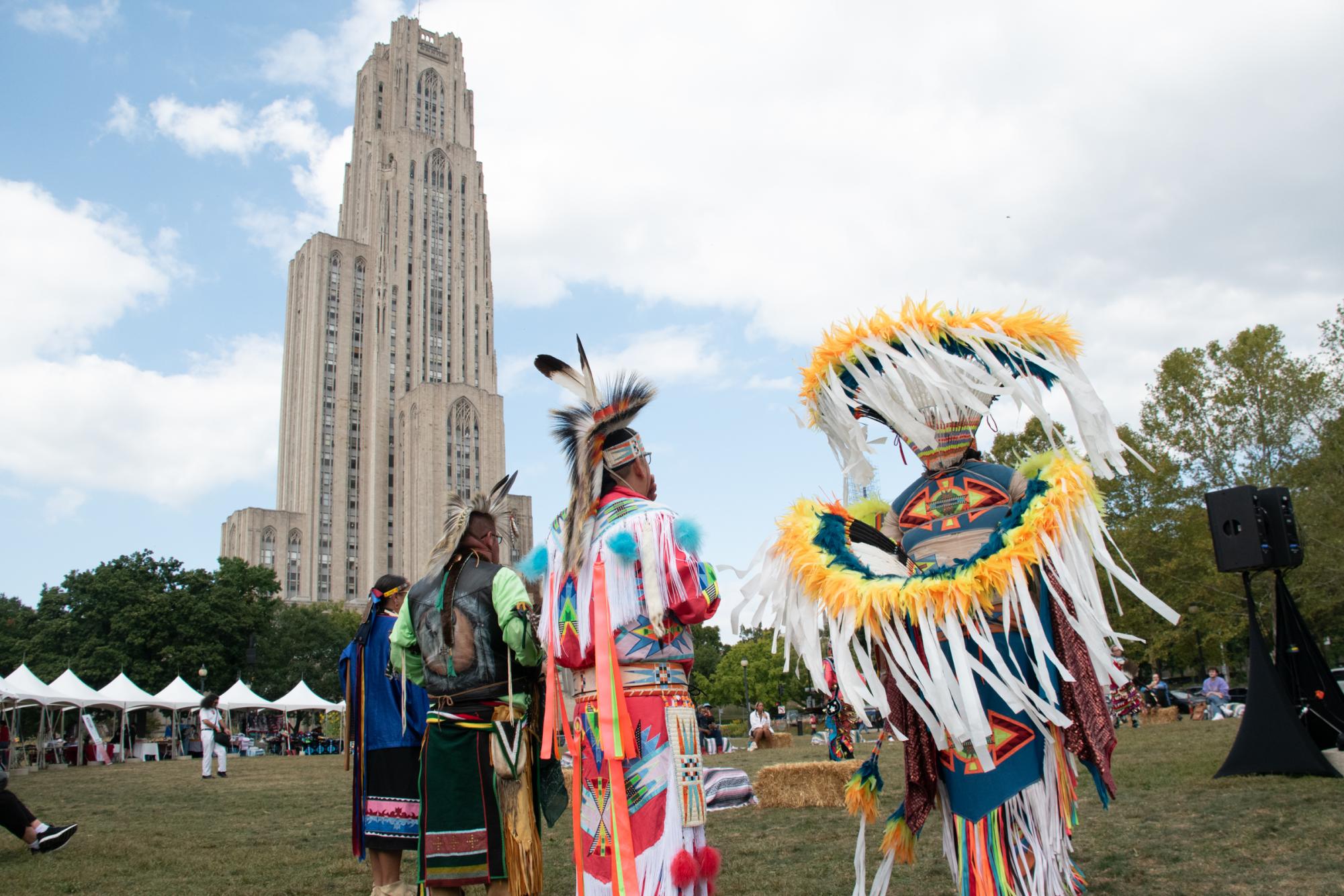Students walking along Forbes Avenue on Wednesday afternoon heard the echoes of music from the powwow in Schenley Plaza. The Council of Three Rivers American Indian Center (COTRAIC) held the event in conjunction with Pitt’s Office of Diversity, Equity and Inclusion. A powwow is a Native American ceremony that includes singing, dancing and celebrations of Indigenous culture. As students drew closer to the plaza, loud drums and the tinkling of Native American regalia greeted onlookers of the cultural festivities.
Wednesday’s event was part of a weeklong series documenting and celebrating Native American culture during Pitt’s Indigenous Cultural Festival. In addition to the powwow, the festival included an Indigenous exhibit in the Pitt Global Hub, a display in Hillman Library and other educational experiences such as a dreamcatcher workshop.
Michael Simms, the powwow coordinator for COTRAIC, facilitated the event for its second year on campus. The larger powwow in Dorseyville is celebrating its 44th anniversary this weekend. Simms said that he enjoys seeing the events come to fruition.
“My favorite part is watching it all come together and actually happen,” Simms said. “Being part of the behind-the-scenes and all the planning allows you a sigh of relief, as you see everything unfold in front of you as [the] powwow begins.”
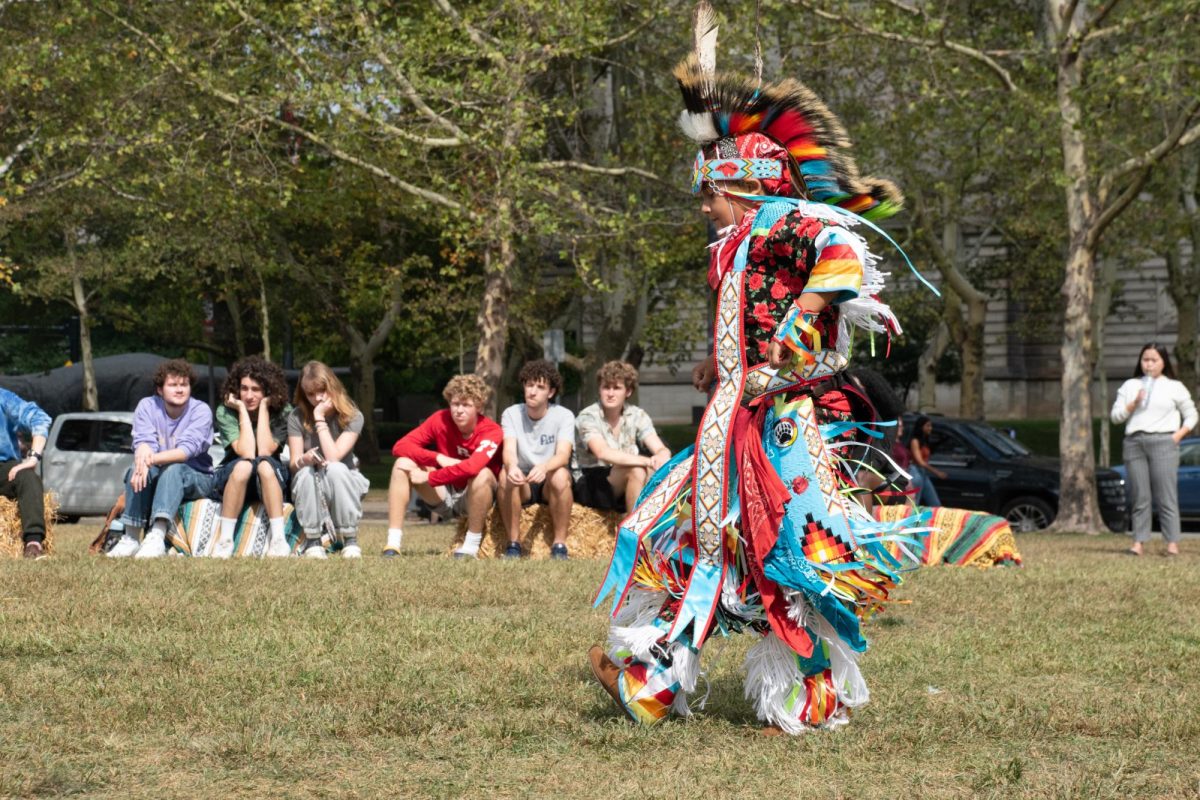
The program began with opening remarks and tribal dancing in front of a crowd of guests sitting on hay bales in the plaza. Drummers played an intricate song while dancers, dressed in traditional regalia, joined hands and performed a dance together. Krisha Spangler of the Mohawk tribe participated in a dance called the two-step. Spangler said everyone could participate in the dance.
“The last dance we did was a two-step, where couples would dance together. That’s one of our social dances. A lot of our dances are separated into different categories based on what style you dance,” Spangler said. “That was one of our social dances where no matter what style you dance, or your age or ability, it was a dance where everyone could come together and enjoy time with one another.”
During the lunch break, people sat together laughing loudly and enjoying each other’s company as the festivities paused. Spangler, who traveled to powwows as a child, loves the social aspect of these events. She said people come from far and wide to share their culture and celebrate with friends.
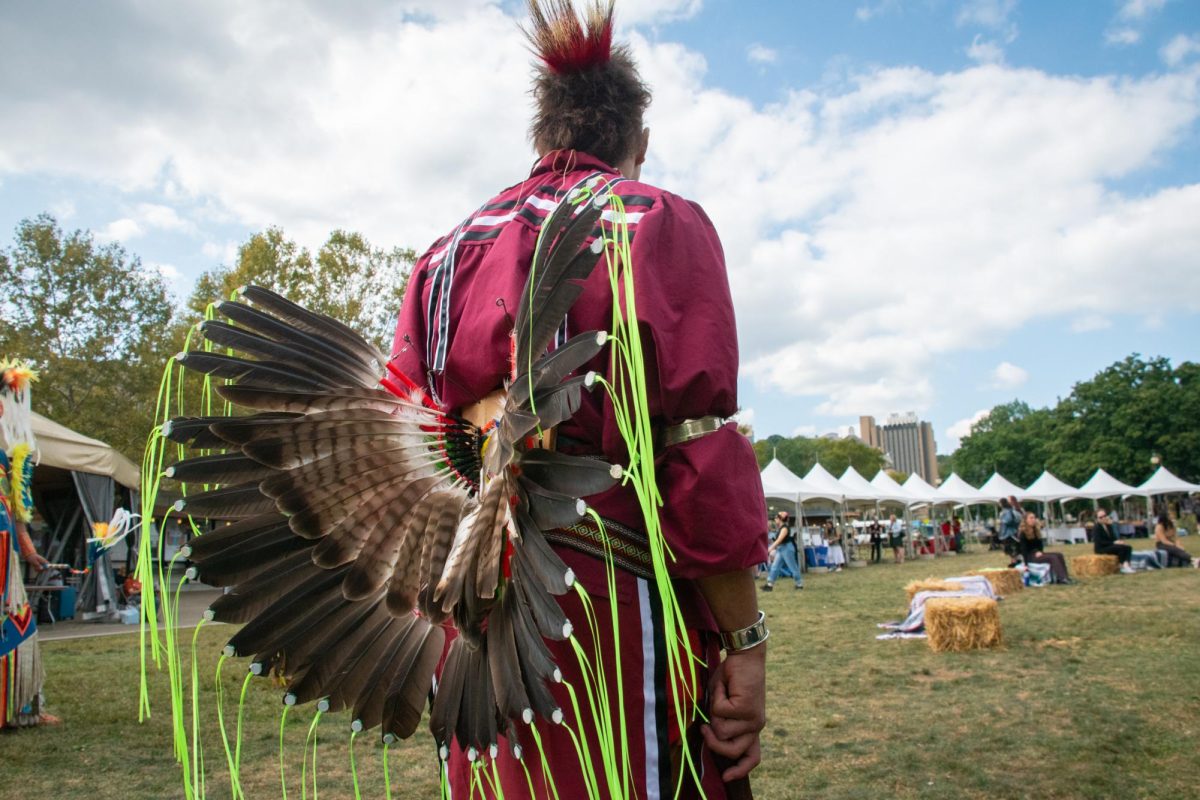
(Amaya Lobato | Assistant Visual Editor)
“For example, our drum group, they’re from North Carolina. We have some of our male dancers that came down from Canada,” Spangler said. “When everyone comes together like this, it’s kind of like our family reunion. So seeing everyone that’s your friends, and you’ve made those connections and relationships was really awesome.”
Unlike the southwest or Pacific northwest where Native American culture is more visible, Pennsylvania’s Indigenous population ranks third-lowest of any state. Spangler said bringing Native American culture to those who normally cannot access it is vital.
“[It’s important] for individuals who may be Native to make a connection here in their hometown or where they’re going to college, if they’re away from home,” Spangler said. “Here in Pennsylvania, we do not have any reservations. Luckily, we do have the Council of Three Rivers American Indian Center, and that allows us to keep together and keep our community strong.”
Katie Boyes, a junior environmental studies major, was one of the students enjoying the festivities. When she attended this event last year, a speech about the degradation of rivers in Pennsylvania brought her to tears. She said it was an important reason she came back this year.
“That is definitely my favorite part, along with the art and the culture. The awareness this brings is super important,” Boyes said. “Everyone’s speaking to each other, and having really interesting conversations and dialogues, which is definitely something important to bring to a campus.”
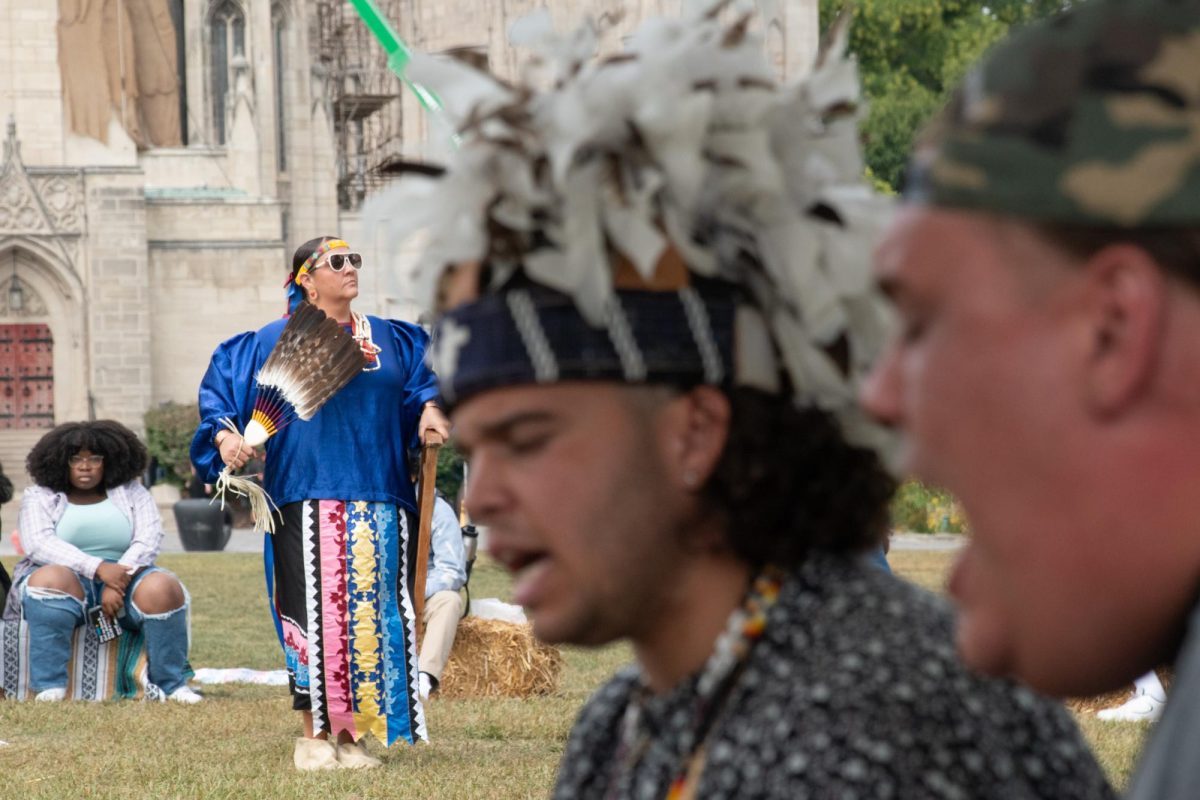
(Amaya Lobato | Assistant Visual Editor)
In addition to the traditional dancers, vendors lined the edge of the park, offering products such as soaps and handmade goods that were crafted with Native American culture in mind. Naiche Tayac, hailing from the San Carlos Apache Tribe in Arizona and Piscataway in Maryland, has worked as a vendor with his father since his youth.
“I sell all handmade jewelry, like earrings, rings and necklaces,” Tayac said. “They are all set with different stones such as turquoise, lapis lazuli, spiny oyster, opal and coral. Then everything is all set in sterling silver.”

Behind the vendors, children mirrored their parents in identical versions of traditional clothing. Bells tinkled as they ran around each other while laughing and playing games. Chanel Wissner, a member of the Tuscarora tribe of North Carolina, has always enjoyed this portion of powwows.
“I love seeing the little ones get out there and take pride in their culture.” Wissner said.
In addition to seeing youth enjoy their culture, Wissner said cultural exchange is essential, especially on college campuses.
“I also love sharing my culture with other people outside of the Indian community, as well as learning about their culture. So it’s a good exchange,” Wissner said. “I think it’s important because this land is Native land and for people to recognize the people that were here first, but also understand that we’re still here. It’s definitely something that should be celebrated, because our diversity is our strength.”
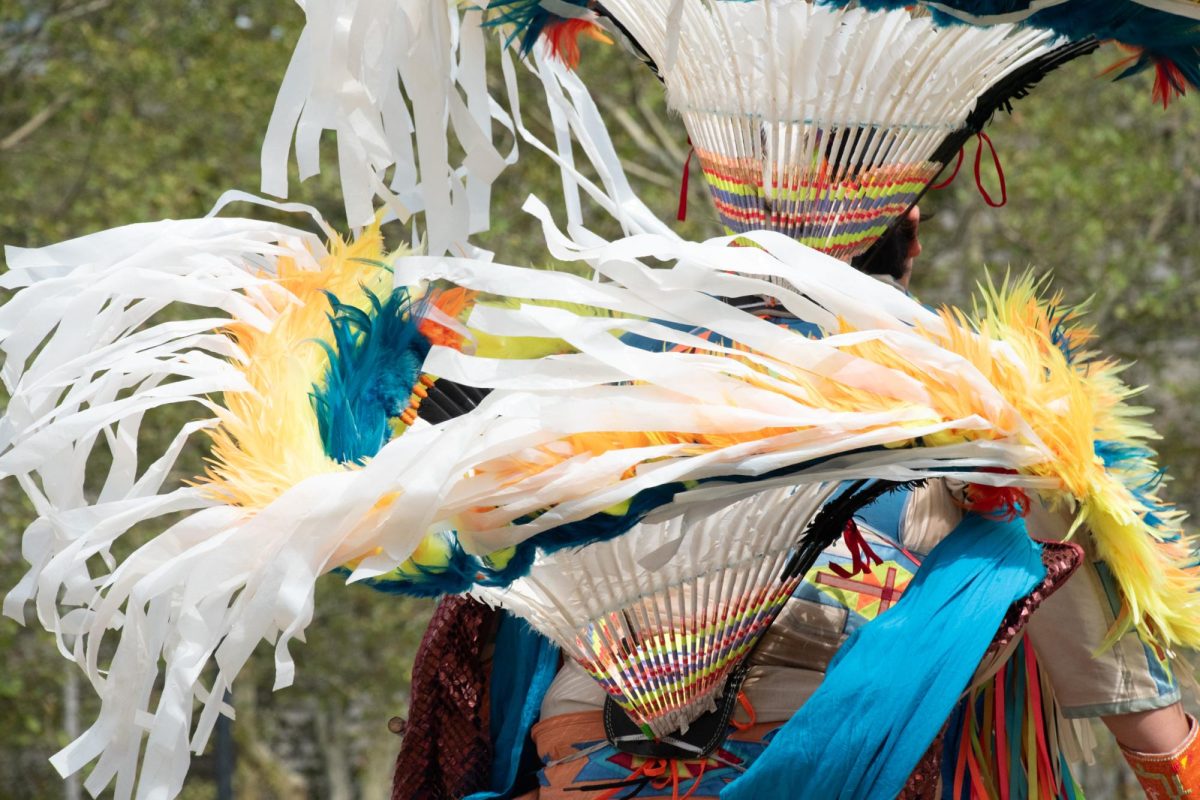
(Amaya Lobato | Assistant Visual Editor)


